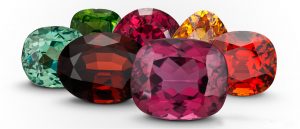Garnet
Mineral: Silicates-Nesosilicates
Hardness 7-7.5
Birthstone: January

Garnets are widespread minerals, particularly abundant in metamorphic rock. All garnets have essentially the same crystal structure, but they vary in chemical composition. There are more than fifteen garnet categories, called species, which make up the Garnet family.
Garnets differ from many other gem groups in that the different species readily combine with each other to form intermediate varieties, or blends, resulting in gemstones in almost every color. Red garnets have a long history, but modern gem buyers can pick from a rich palette of garnet colors: greens, oranges, pinkish oranges, deeply saturated purplish reds, and even some blues.
Thousands of years ago, red garnet necklaces adorned the necks of Egypt’s pharaohs, and were entombed with their mummified corpses as prized possessions for the afterlife. In ancient Rome, signet rings with carved garnets were used to stamp the wax that secured important documents. Garnet is a powerful energizing and regenerative stone. It balances, strengthens and protects. While it is one of the most plentiful stones, each species of garnet has unique properties, color energies and Feng Shui uses.
Types of Garnet:
Almandine– (most common) deep-red, pink-red, fiery-red
Andradite– black, green, yellow Demantoid– dark green, grass green
Grossularite– brown, green, orange-yellow, white, yellow Hessonite– range of orange, reddish-brown
Malaya– orange, red-orange, yellow-orange Melanite– black
Pyrope– red, orange-red, purple-red, all quite dark Rhodolite- pink, purple, red-purple
Spessarite– (rare) orange, red-orange, yellow Mandarin- vibrant orange
Tsavorite– (most prized) bright, dark green Uvarovite- bright greens

